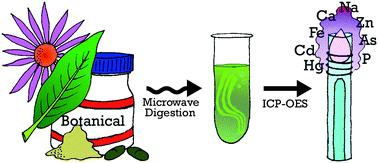Presented here is the development and validation of a simple and singular sample preparation method for the detection of heavy metals (i.e. arsenic, cadmium, lead, and mercury) and other elements (i.e. iron, sodium, calcium, phosphorus, and zinc) in botanical products by microwave digestion and inductively coupled plasma optical emission spectroscopy (ICP-OES). This one methodology is successfully applied to botanical samples existing in three very different forms; powdered raw material, liquid phyto-caps (i.e.glycerin-based matrices) and ethanolic tinctures. Method validation results were obtained by the generation of calibration curves with multi-element aqueous standard solutions and a standard addition method. NIST standard reference material (SRM) 3241 Ephedra sinica Stapf Native Extract, SRM 3243 Ephedra-Containing Solid Oral Dosage Form and SRM 3246 Ginkgo biloba (leaves) were used for the method validation. Limits of detection obtained from the calibration functions range from 4 to 100 ng/mL. Concentration ranges determined for the various botanical extracts were as follows: iron (1–434 µg/g), sodium (3–6742 µg/g), calcium (4–46537 µg/g), phosphorus (24–14710 µg/g), and zinc (7–7247 µg/g). For the majority of the heavy metals (As, Cd, Hg and Pb) the concentration results were not detectable (ND), i.e. below the detection limits of the method.


 Please wait while we load your content...
Please wait while we load your content...